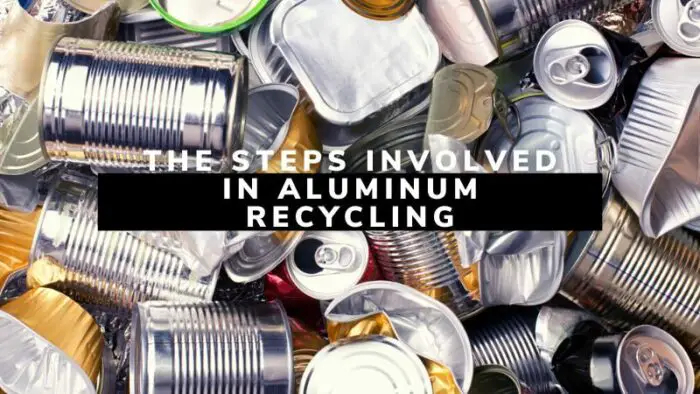Aluminum is a highly recyclable metal that can be melted down and reused repeatedly. Recycling involves collecting used aluminum products, such as soda cans or car parts. These products are then taken to a recycling facility and sorted and cleaned.
Next, the aluminum is shredded or melted down into small pieces. This allows impurities, such as paint or coatings, to be removed. The cleaned aluminum is then melted in a furnace and cast into large blocks called ingots.
From there, the aluminum ingots can be transported to manufacturers who use them to create new products. Recycling uses just 5% of the energy required to produce aluminum from raw materials, making it much more environmentally friendly.
In addition to conserving energy, recycling aluminum reduces greenhouse gas emissions and conserves natural resources. It takes about four tons of bauxite, a type of rock, to produce one ton of aluminum. Bauxite is a nonrenewable resource, so recycling aluminum helps to reduce the demand for new bauxite mining.
Overall, aluminum recycling is vital to conserve resources and protect the environment. It is also an essential part of the economy, with many people working in the recycling industry.
How Aluminum is Recycled
When aluminum is recycled, it is collected and taken to a recycling facility, where it is processed and prepared for reuse. The process of recycling aluminum involves several steps:
- Collection: Used aluminum products, such as soda cans or car parts, are collected and transported to a recycling facility.
- Sorting and cleaning: The aluminum is sorted and cleaned at the recycling facility to remove impurities such as paint or coatings.
- Shredding or melting: The aluminum is then shredded or melted down into small pieces, making removing impurities easier.
- Purification: The aluminum is then purified to remove any remaining impurities and contaminants.
- Casting: The pure aluminum is melted in a furnace and cast into large blocks called ingots.
- Transport and manufacturing: The aluminum ingots are then transported to manufacturers who use them to create new products.
There are variations to this process, but most aluminum recycling follows a similar approach.

How Much Aluminum is Recycled?
According to the Aluminum Association, about 75% of all aluminum produced is still in use today. This is primarily because aluminum is a highly recyclable material. When aluminum products end their useful life, they can be recycled and made into new products, which helps conserve resources and reduce greenhouse gas emissions.
In the United States, aluminum recycling has a long history, with the first aluminum recycling plant opening in 1911. Today, the U.S. recycling rate for aluminum cans is around 50%. This means that about half of all aluminum cans are recycled, while the other half end up in landfills or is otherwise discarded.
Uses for Recycled Aluminum
Many factors can influence the recycling rate for aluminum, including the availability of recycling programs, the cost of collecting and processing aluminum, and the demand for recycled aluminum in manufacturing. Overall, the aluminum industry is committed to increasing recycling rates and reducing the environmental impact of aluminum production.
Recycled aluminum is a valuable resource that can be used in many applications. Some of the most common uses for recycled aluminum include:
- Packaging: Recycled aluminum is often used to make new food and beverage containers, such as soda cans and beer bottles.
- Transportation: Aluminum is a lightweight and strong material widely used in the automotive industry. Recycled aluminum is often used to make car parts, such as engine blocks, wheels, and body panels.
- Construction: Aluminum is also used in the construction industry, commonly used to make window frames, doors, and other building components.
- Electrical: Recycled aluminum makes electrical transmission lines and components such as wiring and transformers.
- Other products: Recycled aluminum is also used to make many other products, including appliances, sports equipment, and furniture.
Overall, recycled aluminum is a vital resource in many industries and applications. By recycling aluminum, we can conserve resources and reduce the environmental impact of production.
How Many Times Can Aluminum be Recycled?
Aluminum is a highly recyclable material that can be recycled indefinitely without losing quality or performance. This means that aluminum can be recycled repeatedly, indefinitely, without losing its properties or becoming less effective.
The recycling process for aluminum involves melting down used aluminum products and purifying the metal to remove impurities. The refined aluminum is then cast into ingots, which can be used to make new products. This process can be repeated as often as necessary without losing quality or performance.
Conclusion
In conclusion, aluminum is a highly recyclable metal that can be melted down and reused repeatedly. The recycling process starts with collecting used aluminum products, which are then taken to a recycling facility, where they are sorted, cleaned, and melted down into small pieces. The pure aluminum is then cast into ingots, which can be used to make new products.
Recycling aluminum conserves resources, reduces greenhouse gas emissions, and helps to protect the environment. It is an integral part of the economy, with many people working in the recycling industry. The recycling rate for aluminum in the United States is around 50%, which means that about half of all aluminum cans are recycled, while the other half end up in landfills or are otherwise discarded.
There is still room for improvement in aluminum recycling rates, and the aluminum industry is committed to increasing recycling and reducing the environmental impact of aluminum production.

